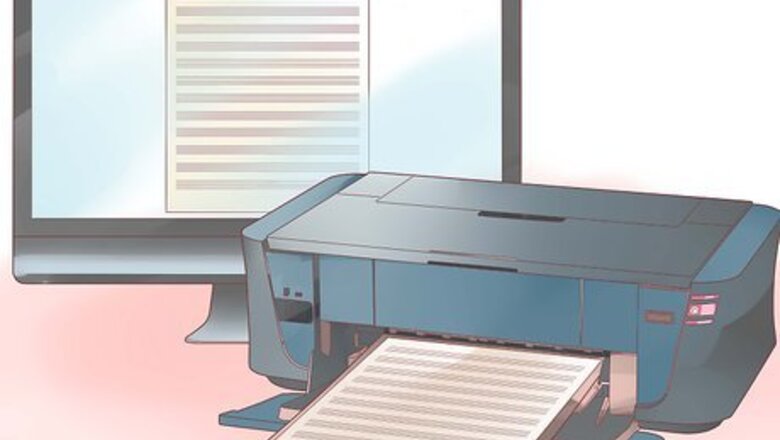
views
Choosing a Composition Method
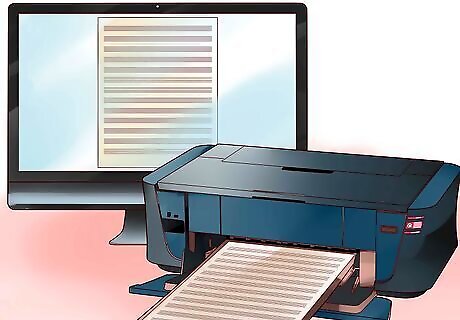
Download and print some free notation paper. Sheet music is written on lined notation paper, featuring blank staves on which you can print notes, rests, dynamic markers, and other notes to guide the instrumentalists as they play. If you want to write sheet music free-hand, the old fashioned way of Mozart and Beethoven, don't worry about drawing your staves on a blank piece of paper with a ruler. Instead, find some free blank staff paper online that you can print out quickly to start filling in with your compositions. If you are really serious though, it would be a better idea to go to a music store and get staff paper there. Its not free like online but your work will look more professional. On many sites, you can even pre-set the key and add the clef markers without having to fill them in yourself. Configure the staves like you want them, download the files, and print them out from your computer. Print out plenty of sheets to practice on and start your compositions in pencil. It can be a messy business trying to get your complicated ideas out on paper, so it helps to be able to erase and make little changes without having to recopy the whole thing.
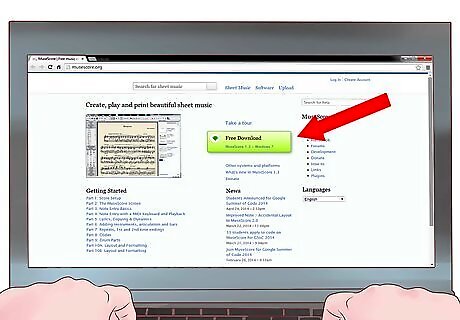
Download music composition software. If you want to compose on your computer, you can use software to drag and drop notes, make quick changes and revisions, providing you with easy access and quick saves. Composing on the computer is increasingly popular among contemporary composers, saving you time and effort in writing music. MuseScore is a popular software, easy-to-use and compatible with either freestyle composition or MIDI inputs. You can record directly onto the staves or work by building your piece up note-by-note. Most composition software also features MIDI playback, so you can hear what you've just written in digital version. GarageBand also comes standard on most new Macs, and can be used to write sheet music by selecting a "Songwriting" project. You can record live sounds or input an instrument directly to transcribe into musical notation, then click on the Scissor icon in the bottom left corner to check out the notes. Noteflight is a good online site to use if you don't want to spend a lot of money on software as your first ten scores are free when you make an account. Download the software and start a new project to start saving your work. If you input a MIDI keyboard into the computer with a USB cable, you'll be able to play your melody directly onto the keyboard and the software will chart your music on the staff. It's as easy as it gets. You can even layer parts, assigning them to different instruments, to get started on that symphony.
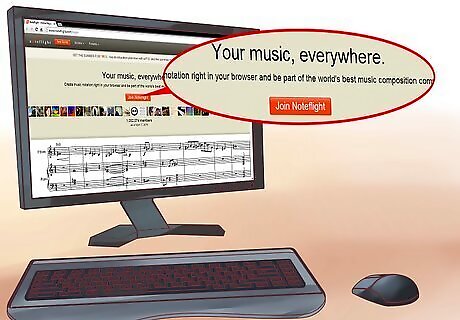
Sign up for a free online composition resource. Online communities of composers and sheet-music readers also exist to compose and congregate over their music. Much like using composition software, you can compose your tune right online and save your work, then make it public and get feedback from other composers, or leave it private and access your composition from anywhere. Noteflight is one such free community, and an excellent resource both for learning to read music, writing music, exploring other peoples' compositions, and posting your compositions.
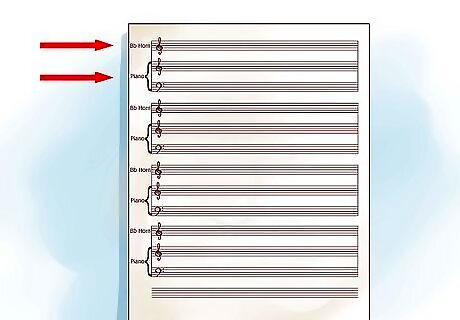
Select an instrument or a group of instruments for which to compose. Want to chart out some horn lines for an R&B song, or write up a string part to back your ballad? It's most common to work on one phrase or instrument at a time, then worrying about harmony and counterpoint later when you've got the first part knocked out. Common charting projects might include: Horn section parts for trumpet (in Bb), saxophone (in Eb), and trombone (in Bb). String quartet for two violins, viola, and cello Piano charts for accompaniment vocal sheets
Starting with the Basics
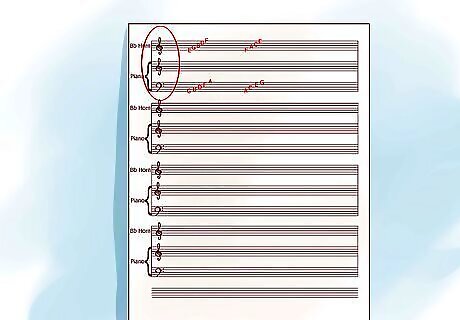
Write the clef on the staff. A page of sheet music is made up of notes and rests printed on five parallel lines and the spaces in between them, which is called the staff. The lines and spaces are counted from the bottom to the top, meaning the higher-pitched notes will be higher up on the staff. The staff can be in either bass or treble clef, which will be marked at the left-most point on each line of the staff. The clef marker will tell you which line corresponds to which set of notes: In the treble clef, also known as "G clef," you'll notice a sign a bit like the ampersand (&), printed on the left side of each staff. This is the most common clef for sheet music. Guitar, trumpet, saxophone and most higher-register instruments will be printed on treble clef. The notes, starting on the bottom line and going to the top line, are E, G, B, D, and F. The notes in the spaces between the lines, starting with the space between the first and second, are F, A, C, and E. In the bass clef you'll notice a sign that looks a bit like a curved number "7" to the left of each line of the staff. The bass clef is used for instruments in the lower register, like trombone, bass guitar, and tuba. Starting with the bottom, or first line, the notes ascend G, B, D, F, and A. In the spaces are A, C, E, and G, from the bottom to the top. The tenor clef is used for choral works. It looks like the treble clef but with a little number 8 under it. It reads just like the treble clef but sounds an octave lower.
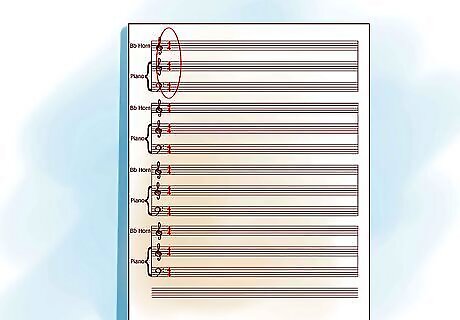
Write the time signature. The time signatures refers to the number of notes and beats in each measure on the staff. On the staff, measures will be separated by periodic vertical lines, separating the staff into little chunks of notes. Just to the right of the clef will be two numbers, one over the other, like a fraction. The top number represents the number of beats in each measure on the staff, while the bottom number represents the value of each beat in the measure. In western music, the most common time signature is 4/4 time, which means there are four beats in each measure, and one quarter-note is worth one beat. You may also see a capital C in place of 4/4. They are the same thing, the "C" is for "common time." 6/8 time, another often used time signature, means that there are 6 beats in each measure and the 8th note gets the beat.
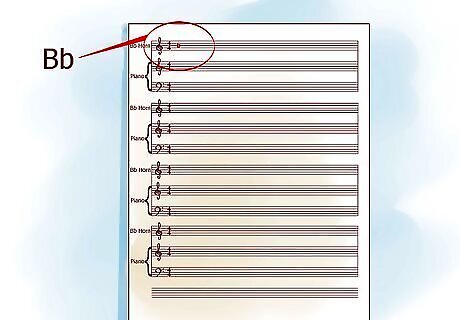
Set the key signature. More information to be included at the left of each line of the staff includes any sharps (#) or flats (b) that will designate the key signature you'll follow throughout the music. A sharp takes a note up half a step, while a flat lowers it half a step. The symbols can appear incidentally throughout the piece for occasional uses, or can appear at the beginning of the piece to follow through the remainder of the song. If, for instance, you see a sharp in the first space in the treble clef, you'll know that each note that appears in that space will need to be played one half-step higher. Likewise, with flats.
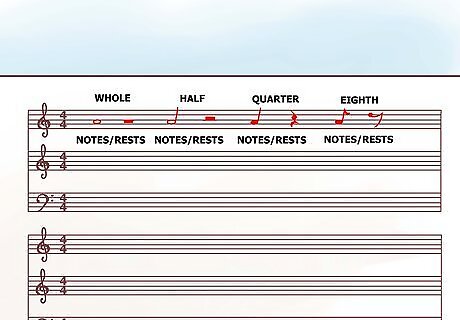
Learn the different kinds of notes you'll use. On the staff will be printed many different types of notes and rests. The style of note refers to the length of the note, and the placement of the note on the staff refers to the pitch of the note. Notes are made of heads, which are either dots or circles, and stems, which trail off from the head of the note, either up or down on the staff, depending on the placement of the note. Whole notes look like ovals, and are held out for 4 quarter notes. Half notes look like whole notes, but with a straight stem. They're held for half the length of a whole note. In 4/4 time, there would be 2 half-notes per measure. Quarter notes have solid black heads and straight stems. In 4/4 time, there are 4 quarter notes in a measure. Eighth notes look like quarter notes with little flags on the end of the stem. In most cases, eighth notes will be grouped together for each beat, with bars connecting the notes to signify the beat and make the music easier to read. Rests follow similar rules. Each whole rest looks like a black bar on the middle line of the staff, while quarter-note rests look a bit like a letter "K" in italics, building stems and flags as they break down into further divisions per beat. A dotted note or rest means that you add half of the value of the note. For example, a dotted half note would be 3 beats and a dotted quarter would be 1 1/2.
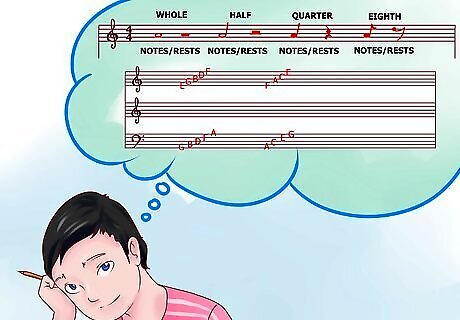
Spend time learning from other scores. Western musical notation is a fairly complex symbolic language that you need to understand to read first if you hope to write it. Just as you couldn't hope to write a novel without understanding to read words and sentences, you can't write sheet music if you can't read notes and rests. Before you try to write down sheet music, develop a working knowledge of: different notes and rests the lines and spaces on the sheet rhythm markers dynamic markers key signatures
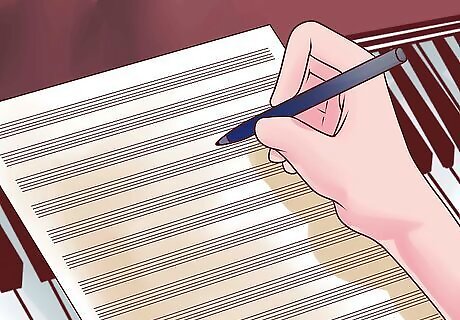
Choose your composition instrument. Some composers compose with their pencil and paper, some compose with a guitar or a piano, and some compose with a french horn in hand. There's no right way to start writing sheet music, but it's helpful to be able to play yourself to practice out little phrases you're working on and hear how they sound. Plunking out some notes on the piano is especially useful for composers to know, since the piano is the most visual instrument--all the notes are right there, laid out before you.
Composing Music
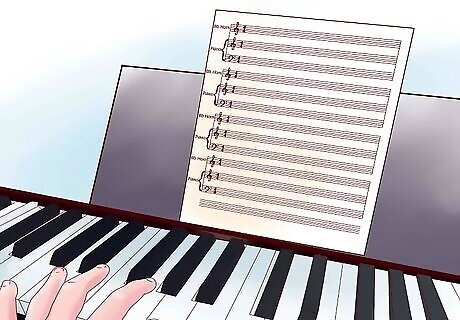
Start with the melody. Most composition begins with the melody, or the lead musical phrase that will follow and develop throughout the composition. This is the "hummable" part of any song. Whether you're writing out solo charts for a single instrument or starting your first symphony, the melody is the place you'll start when you're writing sheet music. Standard melodies normally last 4 or 8 measures. This is because they are the most mathematical and pleasing to the ear, as they are somewhat easy to predict how they will end. As you start composing, embrace happy accidents when they occur. No pieces arrive fully formed and perfect. If you're looking for a new place to go with a melody, jam around on the piano or whatever composing instrument you favor and follow the muse where she leads you. If you're feeling especially experimental, explore the world of aleatoric composition. Pioneered by composition luminaries like John Cage, aleatoric compositions introduce an element of chance into the writing process, rolling dice to determine the next note on a 12-tone scale, or consulting the iChing to generate notes. These compositions will sound dissonant, in most cases, and is not always the best way to start or end a melody. It can however give your piece a unique feel that makes it stand out.
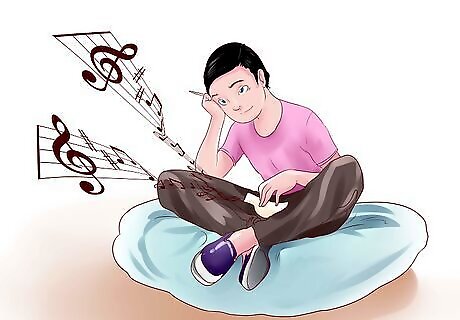
Write in phrases, then chain your phrases together to make the music speak. Once you start with the melody, how do you move the music forward? Where should it go? How does a group of notes become a composition? While there's no easy answer to cracking the Mozart code, it's good to start with small fragments called phrases and gradually build them up into full musical statements. No piece arrives fully formed. Try grouping phrases together in terms of the emotions they evoke. Guitar composer John Fahey, a self-taught instrumentalist and composer, wrote by combining small fragments by "emotion." Even if they didn't necessarily come from the same key or sound like they belonged together, if different phrases felt whimsical, or forlorn, or wistful, he would combine them together to form a song.
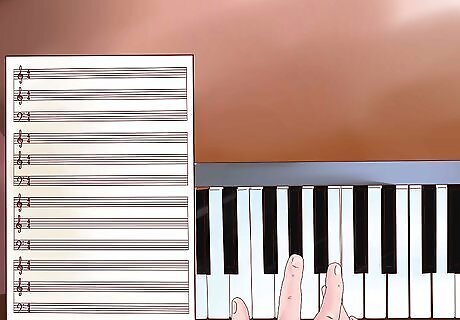
Background the melody with harmonic accompaniment. If you're writing for a chorded instrument--an instrument capable of playing more than one note simultaneously--or you're writing for more than one instrument, you'll also need to compose a harmonic background to give context and depth to your melody. Harmony is a way of moving a melody forward, providing an opportunity for tension and resolution. But don't underestimate they value of just melody. Many times when people start out composing, their melodies have too may chords in them and it is hard to pick out exactly where the melody is.
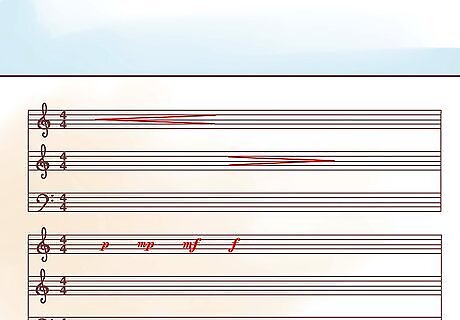
Punctuate the music with dynamic contrasts. Good compositions should swell and subside, should punctuate moments of extreme emotion and melodic peaks with louder dynamics. You can signify dynamic changes in the sheet music with Italian words that signify basic descriptions of loud and soft. "Piano" means that you should play softly, and is usually written below the staff when the music should be played quietly. "Forte" means loud, and is written in the same way. Note the original name of the Piano, the Piano forté; this may help you in remembering that one of the exceptional features of the instrument is it's ability to be a percussion instrument (That also utilizes strings) that can both increase and diminish in sound. If you're not intending a great amount of dynamic contrast in your piece, or don't want to worry about this yet, or you prefer to focus on tonality and rhythm while learning to write, you may consider it's older relatives, the pipe organ and the harpsichord, which have different strengths and will help your fluency on piano. Gradations can be suggested by drawing an elongated "<" or ">" sign under the staff, where the music should either crescendo (get louder) or diminish your sound, depending.
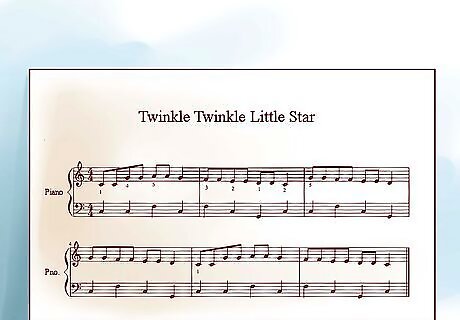
Don't over-complicate your music from need to impress people. The expression process through music is already pretty complicated for most, and there's no need to throw extra dross on that. Depending on your ambitions for your piece, you may want to have multiple parts and polyrhythmic structure, or you may want to have a simple piano melody unaccompanied. Don't be afraid of starting small and refining your work, or leaving a melody undeveloped. Some of the most iconic and memorable lines are the most effective and the most elegant. If you want a reference point from the past century, Erik Satie's "Gymnopedies" provide a classic example of "less-is-more" music writing, and he was considered by many musicologists to be one of the first to write minimalist music. Minimalism in music is a relatively recent trend, as it wasn't popular till after Satie's death, though it has gained considerably popularity today, and is often characterized by techniques such as: Use of a single rhythm or tone structure throughout a piece, primitive melody structure, use of only one or two scales or modes in the context of an entire piece, and exploration of a single theme using a minimal frame: notable examples of minimalism in the last fifty years include works by George Crumb, Phillip Glass, Steve Reich, John Cage & Terry Riley, with an incredible volume of music including such works as minimalist opera and other vocal music (Einstein on the Beach, and Tehillim, for example) Satie's first Gymnopédia was used countless times in ads and film, but there remains something beautiful and moving in it's melancholy melody, though it only uses whole notes and a tonal note structure, not straying from diatonicism for most of the piece. Study Mozart's variations on "Twinkle, Twinkle, Little Star" for an example of turning maybe the most universal of children's melodies into a complex exercise in variation and adornment. It exemplifies the Theme & Variation form, which is one of the most popular and straightforward forms one can write in. Other accessible examples of this form include: Beethoven's "Diabelli Variations", which were a response to a composition his publisher submitted, Michel Rondeau's variations on "Pop Goes the Weasel" and the Enigma variations by Edward Elgar.















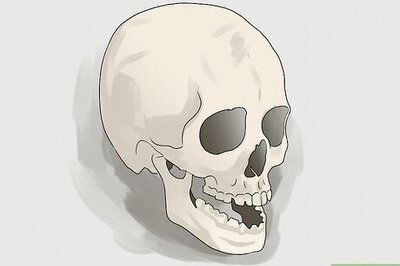

Comments
0 comment